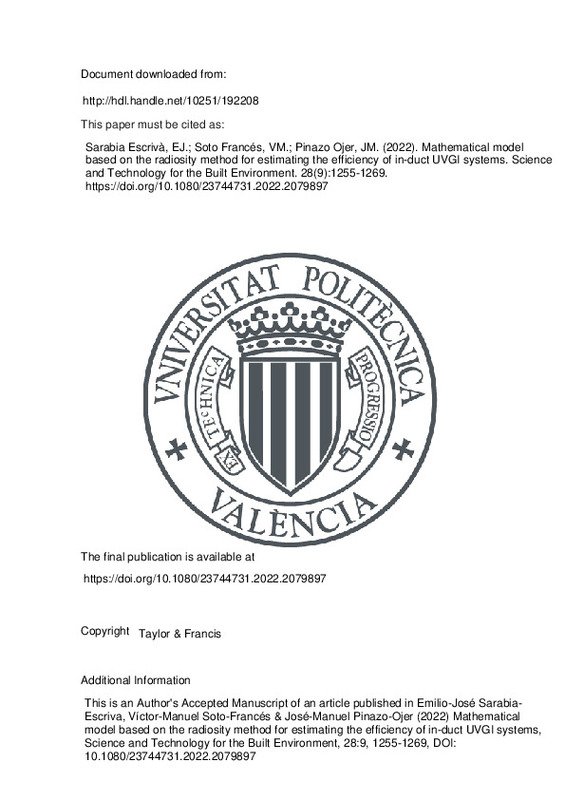JavaScript is disabled for your browser. Some features of this site may not work without it.
Buscar en RiuNet
Listar
Mi cuenta
Estadísticas
Ayuda RiuNet
Admin. UPV
Mathematical model based on the radiosity method for estimating the efficiency of in-duct UVGI systems
Mostrar el registro sencillo del ítem
Ficheros en el ítem
| dc.contributor.author | Sarabia Escrivà, Emilio José
|
es_ES |
| dc.contributor.author | Soto Francés, Víctor Manuel
|
es_ES |
| dc.contributor.author | Pinazo Ojer, José Manuel
|
es_ES |
| dc.date.accessioned | 2023-03-01T19:02:12Z | |
| dc.date.available | 2023-03-01T19:02:12Z | |
| dc.date.issued | 2022-09-27 | es_ES |
| dc.identifier.issn | 2374-4731 | es_ES |
| dc.identifier.uri | http://hdl.handle.net/10251/192208 | |
| dc.description | This is an Author's Accepted Manuscript of an article published in Emilio-José Sarabia-Escriva, Víctor-Manuel Soto-Francés & José-Manuel Pinazo-Ojer (2022) Mathematical model based on the radiosity method for estimating the efficiency of in-duct UVGI systems, Science and Technology for the Built Environment, 28:9, 1255-1269, DOI: 10.1080/23744731.2022.2079897 | es_ES |
| dc.description.abstract | [EN] The article describes a model for calculating the killing ratio of different pathogens with an in-duct ultraviolet (UV) device. The model is based on the radiosity method adapted for the UV radiation range and can be used for analyzing any lamp distribution. The paper provides the necessary view factors and the influence of environmental variables (temperature, humidity and air velocity) in the analysis. The model has been validated using the results of four commercial equipment certificates issued by the US Environmental Protection Agency (EPA). The model results show a high precision on the test results, with a maximum deviation of 9%. In all cases, the model results are lower than that of the test, which allows being on the side of safety in the design. The model has been programmed in software used by Steril-Air for designing its equipment. Finally, an example of calculating the SARS-CoV-2 killing ratio with a 4 x 2 lamps arrangement is shown. | es_ES |
| dc.language | Inglés | es_ES |
| dc.publisher | Taylor & Francis | es_ES |
| dc.relation.ispartof | Science and Technology for the Built Environment | es_ES |
| dc.rights | Reserva de todos los derechos | es_ES |
| dc.subject.classification | MAQUINAS Y MOTORES TERMICOS | es_ES |
| dc.title | Mathematical model based on the radiosity method for estimating the efficiency of in-duct UVGI systems | es_ES |
| dc.type | Artículo | es_ES |
| dc.identifier.doi | 10.1080/23744731.2022.2079897 | es_ES |
| dc.rights.accessRights | Abierto | es_ES |
| dc.contributor.affiliation | Universitat Politècnica de València. Escuela Técnica Superior de Ingenieros Industriales - Escola Tècnica Superior d'Enginyers Industrials | es_ES |
| dc.description.bibliographicCitation | Sarabia Escrivà, EJ.; Soto Francés, VM.; Pinazo Ojer, JM. (2022). Mathematical model based on the radiosity method for estimating the efficiency of in-duct UVGI systems. Science and Technology for the Built Environment. 28(9):1255-1269. https://doi.org/10.1080/23744731.2022.2079897 | es_ES |
| dc.description.accrualMethod | S | es_ES |
| dc.relation.publisherversion | https://doi.org/10.1080/23744731.2022.2079897 | es_ES |
| dc.description.upvformatpinicio | 1255 | es_ES |
| dc.description.upvformatpfin | 1269 | es_ES |
| dc.type.version | info:eu-repo/semantics/publishedVersion | es_ES |
| dc.description.volume | 28 | es_ES |
| dc.description.issue | 9 | es_ES |
| dc.relation.pasarela | S\468847 | es_ES |







![[Cerrado]](/themes/UPV/images/candado.png)

